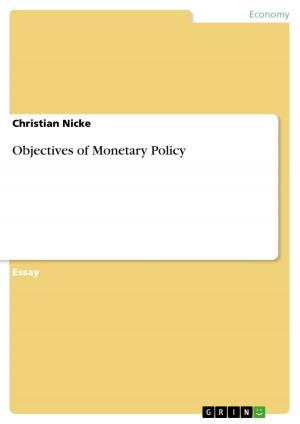United Nations Security Council Resolution 242 and the Controversy Over Varying Interpretations of the Withdrawal Clause
Nonfiction, Social & Cultural Studies, Political Science, International, International Relations| Author: | Belabbes Benkredda | ISBN: | 9783638195911 |
| Publisher: | GRIN Publishing | Publication: | June 5, 2003 |
| Imprint: | GRIN Publishing | Language: | English |
| Author: | Belabbes Benkredda |
| ISBN: | 9783638195911 |
| Publisher: | GRIN Publishing |
| Publication: | June 5, 2003 |
| Imprint: | GRIN Publishing |
| Language: | English |
Essay from the year 2003 in the subject Politics - International Politics - Topic: International Organisations, grade: First Class (70 Prozent), University of Exeter (Politics Department), course: International Relations of the Middle East, 14 entries in the bibliography, language: English, abstract: United Nations Security Council Resolution 242 remains to this day, almost 36 years after it was adopted unanimously, the only internationally-agreed framework for a peaceful settlement of the Middle East conflict. The principle of exchanging land for peace, as expressed in resolution 242, has been the foundation of US, Western and Arab peacemaking efforts. Yet it has also been the subject of a heated debate. Notably the centrepiece of resolution 242, calling for 'Withdrawal of Israel armed forces from territories occupied in the recent conflict', has been interpreted in significantly different ways by the parties concerned. While to the Arabs this means the withdrawal of Israeli armed forces to the positions they held before the outbreak of hostilities - a return to the status quo ante - the proponents of the Israeli position assert that the omission of the definite article before the word 'territories' is aimed at enabling territorial revisions or aggrandizement, particularly in connection with the resolution's second operating paragraph and the mentioning of 'secure and recognized boundaries' therein. The aim of the following essay is to analyse the meaning of UN Security Council Resolution 242. It will start by describing the historical context it is embedded in, namely the events surrounding the June War of 1967. In chapter three, the circumstances preceding the adoption of resolution 242, notably the diplomatic efforts prior to the voting, will be depicted. The next section deals with the differing interpretations of the withdrawal clause. In subchapter 4 c) it will be argued that the adoption of resolution 242 was only made possible due to a number of assurances, given to the Arabs in general and to King Hussein of Jordan in particular, about the intended meaning of the withdrawal clause. Finally, in the conclusions, results shall be summarised and future prospects of a successful implementation of resolution 242 outlined.
Essay from the year 2003 in the subject Politics - International Politics - Topic: International Organisations, grade: First Class (70 Prozent), University of Exeter (Politics Department), course: International Relations of the Middle East, 14 entries in the bibliography, language: English, abstract: United Nations Security Council Resolution 242 remains to this day, almost 36 years after it was adopted unanimously, the only internationally-agreed framework for a peaceful settlement of the Middle East conflict. The principle of exchanging land for peace, as expressed in resolution 242, has been the foundation of US, Western and Arab peacemaking efforts. Yet it has also been the subject of a heated debate. Notably the centrepiece of resolution 242, calling for 'Withdrawal of Israel armed forces from territories occupied in the recent conflict', has been interpreted in significantly different ways by the parties concerned. While to the Arabs this means the withdrawal of Israeli armed forces to the positions they held before the outbreak of hostilities - a return to the status quo ante - the proponents of the Israeli position assert that the omission of the definite article before the word 'territories' is aimed at enabling territorial revisions or aggrandizement, particularly in connection with the resolution's second operating paragraph and the mentioning of 'secure and recognized boundaries' therein. The aim of the following essay is to analyse the meaning of UN Security Council Resolution 242. It will start by describing the historical context it is embedded in, namely the events surrounding the June War of 1967. In chapter three, the circumstances preceding the adoption of resolution 242, notably the diplomatic efforts prior to the voting, will be depicted. The next section deals with the differing interpretations of the withdrawal clause. In subchapter 4 c) it will be argued that the adoption of resolution 242 was only made possible due to a number of assurances, given to the Arabs in general and to King Hussein of Jordan in particular, about the intended meaning of the withdrawal clause. Finally, in the conclusions, results shall be summarised and future prospects of a successful implementation of resolution 242 outlined.















